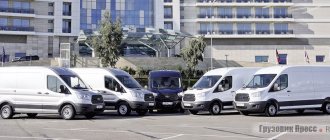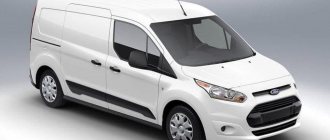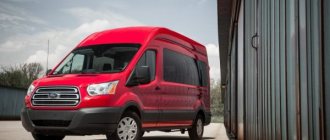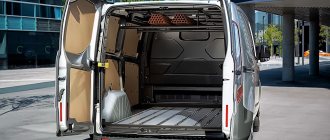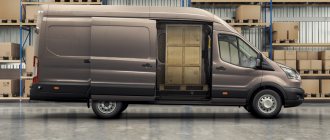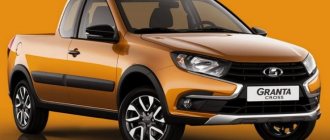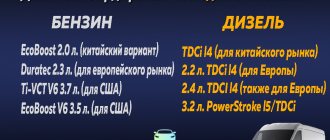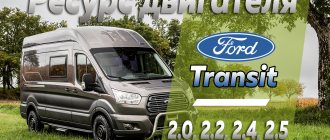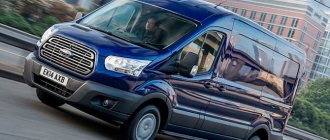Home Brands Ford Ford Transit 2006-2013
The production of the legendary Ford Transit commercial vehicle has been established since 1953, and with the release of each new model, the car gained the greatest popularity. More than six million copies were produced, most of which are still traveling to various corners of the vast planet. This is the most popular commercial vehicle up to 3.5 tons, with which only the domestic GAZelle can easily compete in Russia.
In the second half of 2006, the seventh generation was shown to the general public, which was consistently produced until 2013. Seventh generation transits are still in service with large logistics firms, banks and small and medium-sized businesses.
Design and modifications
The car won the title of best international van in 2007. In honor of this event, the company showed the public an unusual modification of the Transit XXL stretch van. The car was sold only in North American markets. It had a standard design, adjusted for its unusual length and the presence of three doors on each side, two of them were sliding. It had more luxurious finishes inside.
A wide variety of modifications are available for buyers of an American van. Models are available for sale with three types of wheelbase lengths: standard, medium, extended. The roof height also varies depending on the modification.
Vans, depending on the type of cargo structure and size, have different tonnage, and shuttle buses can be tourist buses with 15-17 seats and city buses (up to 25 seats).
The standard modification has the following dimensions:
- length – 4863 mm;
- width – 1974 mm;
- height – 2084 mm;
- curb weight – 1800 kg;
- total weight – 3.5 tons;
- load capacity – 1420 kg;
- The cargo compartment volume is 5,200 liters.
The extended modification of the Ford Transit 2006-2013 with a high roof has the following meanings:
- length – 6403 mm;
- width – 1974 mm;
- height – 2623 mm;
- curb weight – 2140 kg;
- load capacity – 1350 kg;
- The cargo compartment volume is 14,300 liters.
In general, the car received a balanced appearance without frills, everything is neat and tasteful. In the front part there is a huge rectangular lighting system with an elongated upper-side corner. The optics has a two-story architecture. The first floor is designed as a square, and the second is spherical in shape.
The seventh generation received a longer version of the hood to give it a modern look. Due to this, the false radiator grille, which is a continuation of the massive front bumper, has been reduced. It consists of two horizontal plates, behind which a thin square grille is hidden. In the very center of Transit is the logo of the American automaker. The entire lower part of the front bumper is a series of air intakes, and in the corners there are niches for fog lights. The extreme parts of the front bumper are represented by turn signal indicators.
The profile features wide wheel arches, some stampings and turn signals. The passenger version has wide footrests. All modifications are equipped with the same side rear view mirrors. The glazing does not take up a large area, and the side doors sliding back with an electric drive can be made either of metal or entirely of glass. Combination options are more common. On one-tonne vehicles, two wheels are installed on the rear axle, on other versions there are 4 wheels.
The rear design of the Ford Transit 2006-2013 is even simpler. Two doors opening on opposite sides, a small bumper made of unpainted plastic and vertically oriented lights in the rear-side pillars. On the left side of the door is where the license plate is attached, and on the right is the door opening handle. Regardless of the height of the roof, one small fog lamp is located strictly above the opening of the luggage compartment at the rear.
Last Hero
That's right, until mid-summer, Ford Transits were the last premiere of the LCV segment to be mass-produced. And vans with a blue oval, thanks to their consumer qualities and reasonable price, felt quite confident in the market, although they did not engage in serious dumping, like some colleagues in the shop.
Alas, the situation has now changed. In addition to regular exchange rate fluctuations (whatever one may say, Russian assembly is still carried out from imported components), another competing model was presented at the COMTRANS'15 exhibition, and another all-metal van with a tempting selection of consumer qualities is about to enter the market. Of course, this is not a reason to panic, but in the fall the LCV segment will become much more crowded. Is there anything to answer the challenge? Based on the results of the test, I can confidently say – THERE IS!
Let's start with the fact that the basic configuration of the Ford Transit is, if not at the level of the VIP configurations of its colleagues, then certainly at the average level.
Keep your fingers crossed: an electrically heated windshield, a programmable preheater, an on-board computer, a dual heated passenger seat and a host of electronic systems responsible for safety and efficiency (like the intelligent battery regenerative charging system, which charges it only when it is really needed, as needed). possible without doing this with the gas pedal pressed?).
To continue the list of trump cards is the cargo compartment. It seems that the Ford designers managed to come to an agreement with the designers, and as a result, a van was born that combines style and cubic shapes. What this gives the carrier is a large usable volume, allowing the transport of large indivisible loads, making maximum use of the entire body space. In addition, the length of the van floor is 3040 mm, i.e. three-meter slats, etc. will lie on it without preventing the doors from closing.
True, I don’t quite understand why the metal partition of the cabin was made right up to the roof; in the previous version there was a very convenient niche above the cabin for every little thing. And yet…
I won’t undertake to describe the cabin at all – you have to try it. It’s not just to look, but to drive several hundred kilometers to experience the work of ergonomists for yourself and understand that a comfortable space can be created in a “workhorse”. The only thing: to the pair of hooks for outerwear on the wall between the passenger and driver's seats, I would add a hook on the left pillar behind the back. After all, the car is a three-seater, and the version without the rear wall will have no hooks at all.
In general, the Ford Transit is statically ready for battle. Let's see what the dynamics show.
Salon
The interior of the cabin looks completely utilitarian, hard plastics are used here, there are huge gaps and extraneous sounds everywhere, but the level of comfort for front passengers and the driver is acceptable, and considering that this is a commercial vehicle, it is absolutely luxurious. The Ford Transit has three seats in front, there is no central tunnel, but there is a parking brake handle between the driver's seat and the passenger sofa.
Scattered throughout the panels are small and large niches that are necessary in this car, and there is also a large number of cup holders of different sizes.
In front of the driver is a 4-spoke steering wheel with a central part in the form of an inverted trapezoid. Behind the wheel is a simple and informative dashboard with large tachometer and speedometer scales, and between the scales there is a non-color display of the on-board computer. The center console is large; in its lower part there is a place for the gearshift knob, and in the central part for two air intakes, between which there is a control unit for an audio system with two speakers. Below is the air conditioning control unit.
The seats have a sufficient range of adjustments, good padding, but poor lateral support.
Technical characteristics of Ford Transit 7
The car was sold with two 4-cylinder diesel power units, the volume of which was 2.2 and 2.4 liters. All engines were equipped with turbocharging, the cylinder arrangement was in-line.
- Engines with a volume of 2.4 liters were mainly sold with a power rating of 140 horsepower and a torque of 375 Nm. But there were also 115 hp. and 310 Nm of torque. The consumption of “heavy” fuel in the combined cycle was around 9-10 liters per 100 km.
- Engines with a volume of 2.2 liters received a greater variety of boosts. Their power line started at 85 hp. and continued up to 155 hp. Torque was 210 and 385 Nm, respectively, and fuel consumption in the combined cycle was 8-9 liters.
- There was also a limited version of the 7th Transit with a turbocharged 5-cylinder engine and an in-line arrangement. The engine was also diesel, its displacement was 3.2 liters, which allowed it to develop up to 200 horsepower and 470 Nm of torque. Fuel consumption was 10-11 liters.
The maximum speed declared by the manufacturer was 147 km/h. All engines met the Euro-4 environmental standard, and after that the 5-cylinder one met Euro-5.
Regardless of the internal combustion engine, only a 6-speed manual transmission was equipped, which can transmit all the power to both the front or rear axle, and to both at the same time.
The suspension of the Ford Transit 2006-2013 has not undergone any changes with the advent of the new generation. The front has the same independent design with MacPherson struts, and the rear has leaf spring architecture with anti-roll bar. The brakes are all-disc, and the front ones are ventilated. It is also equipped with an ABS system. The steering is equipped with power steering.
Main malfunctions of technical components
The technical components have proven to be reliable, but the van also has some shortcomings, for example, the installed motors refuse to work in cold weather without good warming up, and it is also difficult to start the internal combustion engine in cold weather, so pre-heating is indispensable. Often the speed starts to fluctuate. The reason is a clogged EGR valve. Picky about fuel quality. It is not worth pouring with a cetane number below 51. In Russia it is difficult to find original spare parts for technical units.
Steering rods last no more than 80,000 km.
The disadvantage is considered to be the suspension, which will have to be completely rebuilt before 140,000 km.
Notes in a notebook
The test is completed, the van has gone off to log kilometers with colleagues in the workshop, and it’s time for me to sum up the results.
In my personal ranking of small commercial vehicles, the Ford Transit still holds the leading position. Of course, the car is not without its shortcomings, but there are many more positive aspects in it, and first of all, attention to detail is captivating: additional sockets, a huge number of pockets, niches and shelves, interesting technical solutions, such as a large sliding door, which allows you to get by in a minibus without additional emergency exits.
And the new system for selecting bodybuilders, in which all products coming out of bodybuilders’ workshops must be unified, is worth a lot.
I agree that currently the new Ford Transit cannot boast of a low price, but the potential inherent in its design is worth the money. Moreover, the difference in the price tag between the test van and its main classmates in a similar configuration is within the limits of mathematical error. So the choice is yours...
Provided a car for testing

